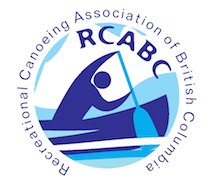Many of you are no doubt aware that in the past few years Transport Canada has been making changes to regulations for canoes and kayaks. Here is a summary of what you need to know as of 2014, with updates from March 2015 regarding guided excursions.
Safety Gear
The requirements for canoe safety gear are essentially the same however the "manual propelling device" is no longer listed. If you're a C1 or big canoe paddler take some time to check the requirements that are pertinent to your type of canoe and situation.
The Transport Canada minimum safety equipment requirements are found here.
All RCABC instructors and club members must carry the Transport Canada safety gear requirements for the trip to be sanctioned by RCABC.
Guided Excursion Guidelines (Commercial)
The "Guided Excursion" guidelines apply to canoe instructors and leaders in a commercial setting. The changes are to the interpretation of the law in the Canada Shipping Act. TC's interpretation now makes a distinction between volunteer and commercial activities, even though the actual wording of the Shipping Act law doesn't. If in doubt, follow the Non-Pleasure Craft or "Guided Excursion" guidelines as they are good practice anyway.
. Using a checklist, the guidelines lay out specific requirements for:
- Pre-Trip Meetings
- Emergency Contacts & Float Plan
- Hypothermia Prevention
- Wearing Helmets and PFDs or Lifejackets
- First Aid Kit (check the minimum requirements)
In order for the courses to be sanctioned by RCABC these requirements must be met.
TC Guided Excursion Compliance Guide TP15204E
If you are in a canoeing leadership role, RCABC has long advocated following the principles reflected in these guidelines. The difference now (as of 2010) is that leaders are now considered Non-Pleasure Craft and regulations in the Canada Shipping Act of 2001 now apply to us and are enforceable. As you read the Compliance Guide, realize that:
- the guidelines apply only to the lead canoe (or leaders).
- the lead canoe(s) are considered NON-Pleasure Craft and the rest of the group are considered Pleasure Craft.
- these guidelines are not exactly the law; they are suggestion or interpretations of the Canada Shipping Act. If you don't take them literally you must meet the intention of the law in the Canada Shipping Act of 2001.
- the Pleasure Craft / Non-Pleasure Craft designation applies to the role of the paddler/leader, and is not boat specific. In other words whatever canoe you are using that day to lead or guide in is considered a Non-Pleasure Craft. The same canoe could be used the next day by your students and it would then be considered a Pleasure Craft.
Registration of Canoes and Kayaks
The good news is you don't have to register your canoe. There has been a bit of flip flop on this, but to Transport Canada's credit they have decided that self propelled craft do not have to be registered.



















